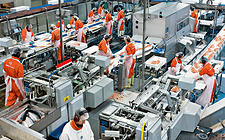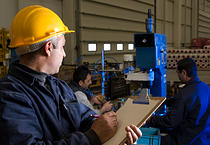We will evaluate your compliance with all of the most common OSHA regulations that apply to private industry. We will document your degree of compliance with each and make written recommendations as to how to comply for those for which you fall short.
Health and Safety
At EMS CONSULTING, we offer the following health and safety services. Click the links for a description of each.
Either following a compliance assessment for which the path to compliance is complex or in the absence of such an assessment, we will develop a plan to achieve compliance and a strategy to implement it. It can be as broad or as narrow as you need – from one OSHA compliance requirement to several dozen. Our plans address written program requirements, implementation, training of both employees and supervisors and any applicable special requirements for individual programs.
Where you need help achieving compliance, we can assist with this for any or all of OSHA’s applicable compliance requirements – whether under the gun to comply or if you want to achieve compliance before you are under OSHA’s microscope
Wherever and whenever you need compliance advice, we can help. We work to your schedule.
Where you are required to report to OSHA we can help – or do it all.
Do you keep an OSHA 300 log? Do you maintain it at all times? Do you use it to report reportable accidents and illnesses at year-end? Do you post it at your facility per OSHA requirements?
Many OSHA programs require training of employees. Did you know that your forktruck drivers must be retrained at least every 5 years or when something about their job changes, whichever comes first? Did you know that they need to carry a “drivers license” and show it upon request?
Is your facility under an OSHA consent decree? These often require that certain employees receive comprehensive training – such as an OSHA 10- or 30-hour training class. Even if everything is copacetic with OSHA, you still need trained and knowledgeable employees. Our OSHA training classes fit the bill. And regardless of which one you take (or send your people to), we forward an OSHA “wallet card” that shows that you – or they – attended. The training is comprehensive, including all or many of the programs on the following list. We can come to you … or you can attend one of the public classes we offer from time to time.
Individual OSHA Program Training
If you don’t need the whole enchilada, consider taking just a small bite – one of two of the classes on the following list.
Do you have maintenance electricians who must work around live electrical wires? If so, you need a written program, very specialized personal protective equipment and extensive training of those employees.
Blood can carry serious, even deadly, diseases that can be passed from person to person, particularly when one person’s blood comes in direct contact with another person. This is of particular concern if you require designated individuals to provide medical attention to others at the workplace. A written program is required, as is annual training, to comply.
Employees can die or become seriously injured if trapped in a confined space, particularly if there are other hazards, such as an oxygen-deprived atmosphere, flammable or toxic materials, or moving parts that could injure or worse. A written program with specific requirements that are spelled out in the regulations is required along with annual training to applicable employees.
Fire safety is important in any environment, including a commercial or industrial workplace. To ensure that the right things happen in the event of a fire and that everyone has an appropriate chance to get away from the fire and out of the building safely is the point of this set of OSHA requirements. Who fights a fire, how to use a fire extinguisher, where to go following evacuation are among the requirements that are needed to addressed in the written plan, which then is the subject of the required training.
If you use flammable materials on site, you need a written program to be followed that will enable the safe storage, transfer, use and disposal of these materials. Your employees must be trained annually on their use, so they can identify which materials are flammable, which are combustible, which are neither and how to avoid fires and explosions … and what to do if one were to occur
ILearn about chemical labeling, safety data sheets, communication of hazards posed by these chemicals to your employees and others working at your facility. The requirements changed over the 3-year period beginning in 2012. The new requirements are now fully applicable, include requirements for initial and annual employee training. If you have been living in a hole, it is time to crawl out and get into compliance.
Learn about chemical labeling, safety data sheets, communication of hazards posed by these chemicals to your employees and others working at your facility. The requirements changed over the 3-year period beginning in 2012. The new requirements are now fully applicable, include requirements for initial and annual employee training. If you have been living in a hole, it is time to crawl out and get into compliance.
If you use ladders at your facility, whether fixed or movable, you need to be safe with them. OSHA has specific requirements to be met for ladder use, including annual training on ladder safety.
Overhead work can be hazardous if not performed correctly or if faulty equipment is used. This regulation specifies requirements for overhead equipment and its use, including inspection of cables and chains and verification that cranes are working properly and that failures are imminent.
Before employees may service or maintain a machine, or the electrical system supplying it power, the machine must be turned off, isolated from all sources of energy, tested to ensure that it is and locked and tagged out to ensure that it cannot be turned back on by others before it is safe to do so. Special equipment is required for authorized employees to use. Both authorized and affected employees must be trained initially and retrained annually. A written program is required.
Yes, you must modify old machines you own to meet the machine-guarding standard – and purchase new ones that meet the standards … even if the manufacturer hasn’t designed the machine to comply with OSHA. And you must train your employees annually on your written plan and how to be safe around the equipment they use and / or are around during the course of their workday.
Safety glasses, steel-toed shoes and earplugs are just a few examples of personal protective equipment. Employers are required to perform a job hazard analysis (JHA) of each job in the facility to evaluate it for hazards, determine if engineering, procedural or administrative controls are required to maximize employee safety and after all else has been implemented, what PPE is required by affected employees to protect them from remaining hazards that can’t be mitigated any other way. Except in rare instances, the employer must supply PPE. A written program and initial and annual refresher training is required. If the JHA finds that respirators are required PPE, there are substantial additional requirements to be met.
Slips, trips and falls are a significant source of injuries in many facilities. The point of these regulations is to prevent injuries from these activities by regulating railings, raised working surfaces, overhead storage areas and flat flooring. A written program and training are both required.
Organizations of a certain size and larger are required to implement comprehensive safety and health programs. EMS CONSULTING can train you on the requirements and guide you to implement an effective, compliant program.
Contact us now to discuss the regulatory compliance issues you need assistance with, whether its assessments of your compliance requirements, compliance plan development and documentation, or employee training.
| Regulatory Compliance | Energy Efficiency and Conservation |
Management Systems | Materials, Clean and Lean Manufacturing |
Sustainability and Green |



